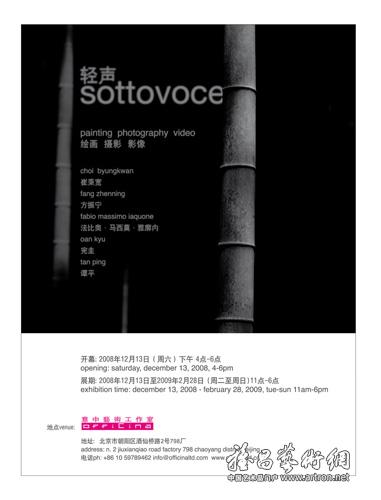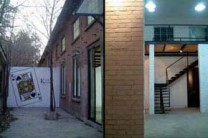"Sottovoce" Hold on OffiCina at 798
2011-04-15 11:31:21

Sottovoce is an Italian word that means to speak in a ‘low voice’, in an undertone, under one’s breath. This new exhibition opening at offiCina art space in Beijing presents artworks from five artists that are different in content and forms but -to some extent- relate to a minimal artistic experience and convey an aesthetic of the void space. A low tone is a choice, an attitude that takes a distance from noise and excess. It means reduction, essential and a decrease of weight along with an extension of lightness. Another common aspect to the artworks in the exhibition is a sense of “lightness”, one of the artistic values that Italian writer Italo Calvino at the end of the ‘80s proposed to bring into the next millennium. In Calvino’s words, it is “thoughtful lightness” and a “grace of the intelligence”. In the arts, it appears as a subtraction of “weight” and has an innate capacity to stand beyond the opacity of the world. In front of these works we experience a similar absence of weight. In different ways, they seem to integrate the same concept of thoughtful lightness. It is a very precise and exact lightness. Each one of them preserves their strength without proclaiming it loudly and disturbingly. The powerful tensions within them arise in an extremely refined manner.
They alternate zones of immaterial sensibility to tangibility, thus creating a specific atmosphere where void plays a definite role. The blank space has significance. It represents an element that mediates between the visible and the invisible. In Eastern aesthetics, the void can be just as significant as the depicted images and lines. It does not mean unfinished or incomplete. Instead, it is dynamic and full of possibilities. Emptiness becomes therefore a precious element. Often unnoticed, it conveys a strong aesthetic quality allowing us to taste the interval, the space ‘in-between’. It may be necessary today – in our cultural times – to regain pause and ‘void’ in front to the excess of ‘fullness’ and of continuous optical and acoustic stimulus that the world we live in impose to each one of us. The void is without boundaries: it cannot be adequately described with words. Silence is another common aspect of these works. It is closer to concentration and distant from the flood of noise that surrounds us. It is a condition of sound and creates effects of suspension. Just like void, silence is full of potential meaning.
Korean artist Choi Byungkwan in his photographs series “Bamboo” conveys the sense of nobility that Asian cultures have assigned to this plant. Bamboo grows still and upright creating void within its body and has become for this reason a symbol of high spiritual values. These photographs were taken in the dense shade of a bamboo forest. Flimsy flashes of light filtrate into the black backdrop of the grove sculpting the shape of the trunks. In this deep darkness, light appears and disappears and the artist’s camera skilfully transforms it into tones of grey and black like the ink on a brush stroke, exploring shades and multiple nuances of minimal colours. Here natural light itself becomes an artistic material. The handling of light creates an interesting tension between physical reality and the immaterial. Such tension is repeated in the dynamic display of bamboo lines inside the frame. Set against the dark emptiness of the background, the bamboo becomes a kind of photographic abstraction, a spiritual representation, and an absolute pure shape. Viewers have the sensation of being immersed in a profound silence and get inevitably drawn into the images. The bamboo representation becomes iconic, eternal, unaffected by the passage of time. It is this literally unspeakable presence that gives to beauty its blinding brilliance, the seductive shine of form.
Tan Ping’s abstract paintings capture viewers for their subtlety and the repetition of circle-shaped conglomerations floating freely on the void space of the canvas, leaving a trace and interconnecting. In his works we visualize the infinite book of shapes that exist in the microcosm and hide behind the microscope. They are cells expanding on space painted with multiple layers of colour. Here we present the works “Gestation” and “Red No. 3”. The interaction between different colours strikes us
strongly. The layers of paint progressively cover and overcome the expansion of the circular abstract forms. Whereas the expansion of the cells produces dissolution of the compactness of world, the sense of space in the canvas plays a specific role as well. The artist’s abstract approach entirely commits to the representation of shapes that belong to his personal life experience. The whole practice is similar to a subtle mental process in which every assessment requires a certain degree of abstraction as it happens in philosophical discourse. The action of juxtaposing layers -instead of adding weight to the final composition- results in an opposite process of cleaning and reduction. It resembles a practice of empting the mind, of purifying the senses as well as exploring the consolatory power of art.
In her artistic practice, the Korean-Italian artist Oan Kyu repeatedly uses signs that, through a kind of meditation manner, open up to discovery and self-knowledge revealing an intense intimate experience. The group of works “Earlier than writing” synthesizes a research that has been carried on for several years. Made out in the traditional form of ink on oriental paper, they highlight a contemporary way of expression that places itself ‘on the borderline’ between exclusively visual image and a kind of hermetic form of ‘writing before writing’. Giving up to any descriptive-narrative intention, the artist paints horizontal lines that during the years have gone through slight changes and have become more intense, more dramatic, showing -as the artist says herself- an ‘urgent and continuous attention to minimal variations’. Focusing on the multiple possibilities of the line, at the edge between painting and calligraphy and similar to music arrangements on paper, these works enable the artist to fulfil her ritual journey in search of her own balance. Lines are never identical but contain continuous variations of density. The stroke never touches the end of the paper and proceeds without interruptions as light as a tightrope walker suspended over an empty space. Here comes the necessity to concentrate and avoid falling down. Oan Kyu’s works should be read ‘between the lines’. Through them we can observe a fascination for recurrences, reiterated signs and at the same time the poetry of unforeseeable changes, of infinite possibilities. There is a need to allow signs to deviate in an unpredicted way from the straight line. Along this line we see a continuous exercise of balance, a perpetual motion similar to water and proceeding towards unknown directions, an intense musical harmony within a minimalist aesthetic horizon.
On the mezzanine level of the gallery space is installed the video work “Miko” by Italian video-artist and director Fabio Massimo Iaquone. The artist invented the concept of ‘DVT’ (Digital Versatile Theatre). Based on innovative technologies, DVT offers a new vision of theatre transforming the scene into a virtual space. To the artist ‘technology is the instrument that allows visualizing our sensations. Far away and beyond noise’. Fascinated by the soul of people and things, he is interested in exploring the possibilities expressed by body and nature and the new frontiers between music and image. In this video work, the body of the Japanese performer Mitsiko Shimura appears on a single sequence shot against a white background. “Miko” herself is rendered in black and white tones. The two colours opposition is exploited to the extreme contrast; the woman’s hair of a dramatic black under the effect of wind resembles brush strokes painting substance over the rarefied white space. The tones become unusual and the body itself turns abstract. While preserving natural movements, the woman melts with the immaculate background and mutates into an installation herself. The refined tonalities and the natural gestures, under the music notes executed by The Katia Labèque Band, translate the whole composition into a remarkable vision reminding us that ‘we are such stuff as dreams are made on’.
In photography, a distinctive attribute of individual style is revealed by the nature of the shot. In Fang Zhenning’s works, to quote his own words, the author has ‘begun choosing a method of consciously squeezing space into an ‘ultra-narrow’ perspective before beginning to shoot’. In a society flooded with information, the artist chooses to reject those that are unnecessary through emphasis on ‘ultra-narrow’. ‘Ultra-narrow photography’ implies a work of reduction and getting closer to the substance. Such reduction belongs to the aesthetic of minimal and emptiness. In this process, digital technique that he practises since 1999 is not used to manipulate but to explore the purity of vision. Conceptually, the ‘revolution of weightless bits’ that accompanies the digital era is consistent to this minimal perspective. While intercepting details of architectures, he creates a kind of abstraction as if the object would exist in another state. These architectural photographs go beyond the representation; the space they show is abstract and not realistic. The subject of the photographs presented here is Casa Malaparte in Capri (Italy), the famous residence built by writer Curzio Malaparte in the 30’s masterly standing on the edge of a cliff where construction is almost impossible. Admired worldwide as a masterpiece of modern architecture, the house symbolizes a ‘place of the mind’. The interest in Fang Zhenning’s rendering is that detail of the external wall of the house - which he dreamed for so many years - becomes the embodiment of a mental image inspired by traditional Chinese painting. The huge rocks in front of the island (the famous Faraglioni) resemble to mountain peaks against the void backdrop of the sky. Landscape turns into an atmosphere of suspended abstraction. Original colours, modified digitally, have the consistency of the air.
Artists:choi byungkwan, fang zhenning, fabio massimo iaquone, oan kyu, tan ping. exhibition time: december 13, 2008 – february 28, 2009, tue-sun 11am-6pm, and address: n. 2 jiuxianqiao road factory 798 chaoyang district beijing

 黄琦
黄琦 测试用艺术
测试用艺术
